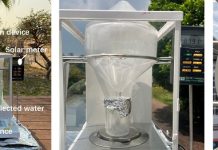
Thirteen years after the Fukushima Daiichi Nuclear Power Plant disaster, scientists have achieved a groundbreaking feat: they have captured the first direct images of radioactive cesium atoms in environmental samples.
This discovery provides valuable insights into the ongoing challenges of managing radioactive waste in Japan.
The study, titled “‘Invisible’ radioactive cesium atoms revealed: Pollucite inclusion in cesium-rich microparticles (CsMPs) from the Fukushima Daiichi Nuclear Power Plant,” was recently published in the Journal of Hazardous Materials. It involved researchers from Japan, Finland, the United States, and France.
In 2011, the Great Tōhoku Earthquake and Tsunami caused meltdowns in three reactors at Fukushima. The disaster led to the release of significant amounts of radioactive cesium (Cs) into the environment.
Researchers have since been studying the fuel debris—melted nuclear fuel mixed with structural materials—inside the damaged reactors to safely remove and dispose of it.
However, many uncertainties about its physical and chemical state complicate this process.
A team led by Prof. Satoshi Utsunomiya from Kyushu University has made significant progress in understanding the chemistry of radioactive cesium.
The Cs-rich microparticles (CsMPs) they studied are small, glass-like particles formed during the reactor meltdowns when molten nuclear fuel mixed with concrete. Many of these particles escaped the reactors and entered the surrounding environment.
Directly imaging radioactive cesium atoms in these particles has been challenging. While cesium is present in high concentrations, the particles are often damaged by the electron beam used for imaging.
However, the team found inclusions of a mineral called pollucite in the CsMPs. This mineral contained more than 20% cesium by weight, much higher than its natural form, indicating it formed in the reactors.
Using a high-resolution electron microscope, Utsunomiya, graduate student Kanako Miyazaki, and their team successfully imaged the cesium atoms within the pollucite. “It was incredibly exciting to see the beautiful pattern of Cs atoms,” said Utsunomiya.
“This is the first time humans have directly imaged radioactive Cs atoms in an environmental sample.”
This discovery is more than just a scientific achievement.
It provides crucial information about the distribution of cesium within the Fukushima reactors and the environment. Prof. Gareth Law from the University of Helsinki, a study collaborator, explained that understanding the properties of these particles is essential for developing effective reactor decommissioning and waste management strategies.
The study’s findings also raise new considerations for environmental behavior and human health impacts of cesium-pollucite. Collaborator Emeritus Prof. Bernd Grambow from Subatech, IMT Atlantique Nantes University, noted that the chemical reactivity of pollucite in the environment and in the human body is different from other forms of cesium fallout.
Reflecting on the study’s significance, Prof. Rod Ewing from Stanford University emphasized the importance of continued research to inform debris removal and environmental remediation strategies.
“The painstaking analytical efforts of international scientists can unlock the mysteries of nuclear accidents, aiding long-term recovery efforts,” he said.
This groundbreaking work highlights the ongoing need to understand and manage the aftermath of the Fukushima disaster, ensuring safer and more effective cleanup efforts.
Source: University of Helsinki.



